In my ongoing quest to find budget alternatives to the several thousand-dollar watches I pine over, I’ve discovered a new timepiece for which I’ve developed mixed feelings. The Duxot Henri Diver Automatic is the latest in my collection. I bought it after trying on an Omega Seamaster Professional 300m with the white dial and falling in love with it. Knowing it’d be a while before I could afford the Omega, and realizing it was just a little too large for my small wrists, I set out a suitable alternative.
I wanted a dive watch with a white dial (ideally with a wave pattern or something else interesting), a black bezel, a lug-to-lug 47mm or smaller, and around $300 or less.
When I first found the Duxot Henri, it was marked down from its $785 MSRP to $149. When I checked again, it was closer to $400 and change. But when the price dropped back to $149, I nabbed it.
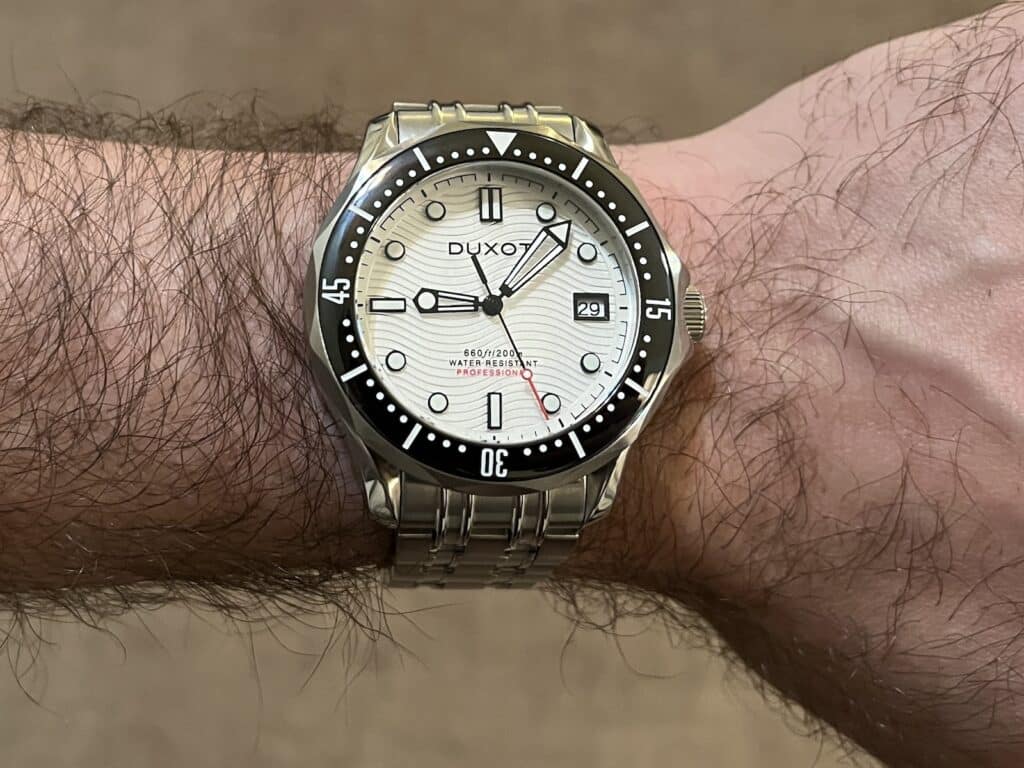
Duxot appears to make homages mostly, resembling popular models from Rolex, Omega, and Patek Philippe with small variations. The Henri, for example, lacks the prominent helium escape valve of the Omega, but overall, the watch and bracelet look very similar. The Marcel, with its fluted bezel and presidential-style bracelet, strikes a serious resemblance to the Rolex Datejust. Its other designs also appear heavily inspired by Daytonas, GMT Masters, Oyster Perpetuals, Submariners, and Nautiluses (Nautili?).
With a market saturated with homages and outright rip-offs, it’s hard to see much originality in the designs. However, there’s also only so much brands can do in the watch space to be original and sell watches under $1,000 (some of their “limited edition” watches retail over $2,000 but can likely be had cheaper). Having had this watch for a week now, I’ll give my initial impressions—the good, the bad, and the uninspired.
Case
Generally speaking, the 41mm stainless steel case wears well on the wrist. It’s slightly smaller in case diameter and lug-to-lug than the Seamaster it’s based on. Looking top down on the watch, it looks great on the wrist, even a small, 6-inch wrist like mine with a 47mm lug-to-lug.
Compared to the 42mm Seamaster with a 49.9mm lug-to-lug, it looks and feels more well-balanced for a wider variety of wrist sizes. My one gripe about the overall profile of the Henri is its skyscraper-esque height of 15mm. Part of what drew me to the design is that, despite it being a dive watch, it can easily be worn with a bathing suit or a suit-suit and not look out of place. Maybe with larger wrists, the watch wouldn’t feel so thick, but this watch rivals my G-Shocks and Suunto Core in height, complicating its ability to slide under a shirt sleeve as easily as other dressier sports watches.

An automatic should be expected to be thicker than their quartz counterparts, generally speaking, but this one just has so much heft, it gets unwieldy at times, especially while doing something active. I find myself taking extra care not to bang the case or sapphire crystal against things.
The rounded edges on the bezel certainly help the watch slide under cuffs and dull the aggressive, sporty vibes that plague so many dive watches that their owners hope to “dress up.” While I’m not a diver, I can’t speak to the “bite” of the serrations on the bezel and its ease of rotating with diving gloves on, but it was easy enough to spin with soft wool winter gloves.
I have several notes (call them complaints) about the screw-down crown. While I appreciate the simplicity of the design, the engraved shape on it doesn’t appear to be the company’s logo or have any other significance and feels like an afterthought.
More importantly, however, is the roughness of the crown when I first unscrewed it. With this being my first Duxot, it’s unclear if this is a one-off or something inherent to their quality control, but it doesn’t give them points on the first impression. One week later and after screwing and unscrewing it a dozen times, it hasn’t smoothened out.
This isn’t likely to impact its waterproofing, but does speak to issues with finer details you’re far less likely to see in a more established (and more expensive) brand.
The lugs curve seamlessly into the body of the case offering a nice overall shape to the case. The distance between the spring bar holes and the case make some straps – particularly NATOs and thicker leather straps – a bit awkward, but more on that further down.
The watch is rated to 200m of water resistance but the issue with the screw-down crown makes me iffy – err, it would if I ever swam deeper than a few feet. Your mileage may vary, so tread lightly if you plan to actually dive with this.
Dial
While not the first or most high-end watch to sport a wave dial, the Henri pulls it off nicely with the pattern striking a nice balance between subtle and noticeable. The waves appear to have a small degree of texture which changes under different lighting conditions and angles, which are made even more apparent under the domed crystal.
The applied indices are a nice touch for a watch at this price, with a double baton index at 12 o’clock, a single baton at 6 and 9, a date window at 3, and circle indices on each remaining hour.
The date window splits from the design on the Seamaster, which is at 6 o’clock and has a more subtle silver border around the window. While setting the date on the Duxot, the crown turned smoothly and there was a positive and satisfying alignment which isn’t always the case on cheaper watches.
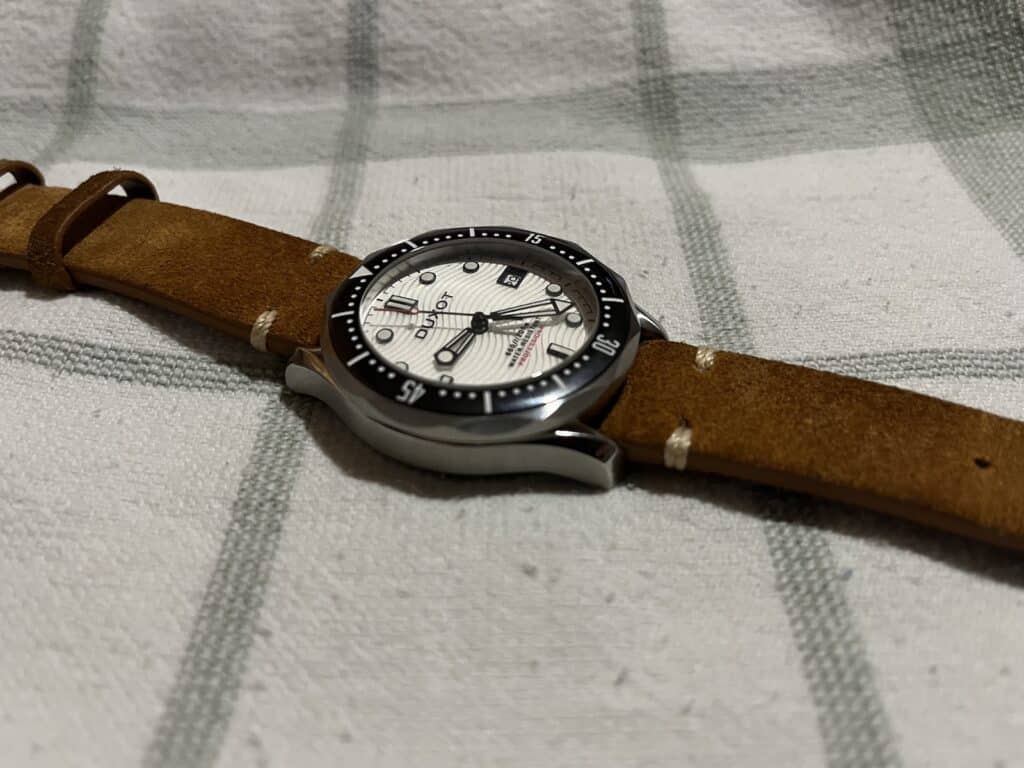
The three hands look almost identical to those of the Seamaster with a thick dagger profile on the hour and minute hand and a lollipop-style second hand. In fact, the only noticeable difference is the red tip on the second hand of the Duxot extends to the circle of the “lollipop,” while on the Omega, the circle remains black.
The lume on the watch is strong for such a relatively inexpensive watch, but it does need direct and prolonged exposure to sunlight or artificial light for it to really shine. Sitting in a room all day with windows open isn’t enough to let the hands and indices shine when the light fades from the room for the day.
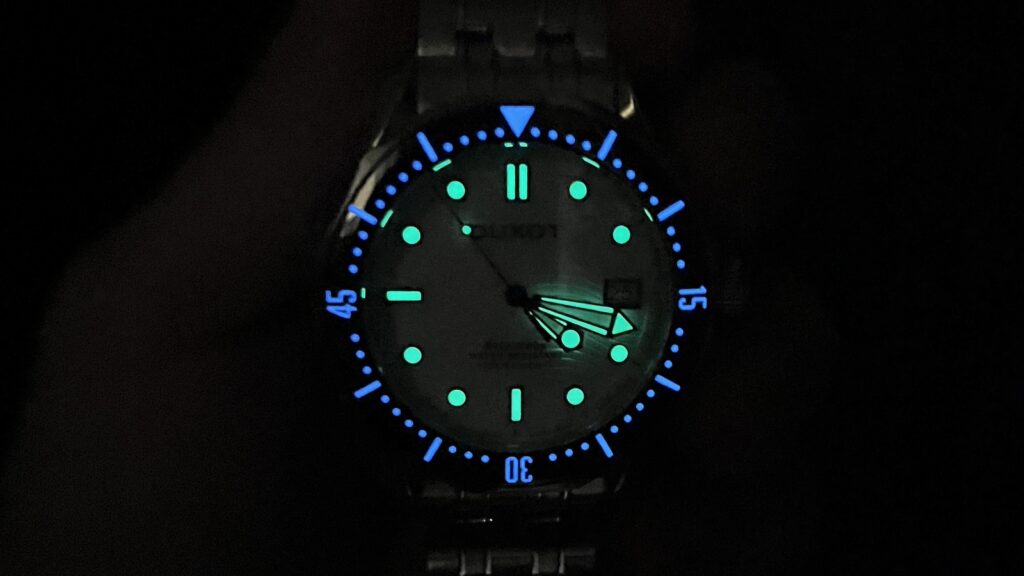
But when worn outside for a few hours or hit with a bright flashlight for a few seconds and brought into the dark, the indices and minute and second hands shine a bright green while the bezel markers glow blue. It was admittedly satisfying to see the first time testing it.
The bottom of the dial reads, from top to bottom, “660ft/200m, WATER RESISTANT, PROFESSIONAL,” with the word “professional” bearing the same red color as the end of the second hand. The red definitely adds a welcomed bit of color to this otherwise black, white, and steel watch.
Movement
As I mentioned in a previous review, I own more quartz watches than automatics, but the odds are evening after I sold a Seiko quartz to make space in my watch box (and my bank account) for the Duxot. The second hand sweeps smoothly at 4 beats per second. While not as refined as higher-end automatics, the Seiko NH35 movement offers that attractive sweep with solid alignment with the second markers on every fourth beat.
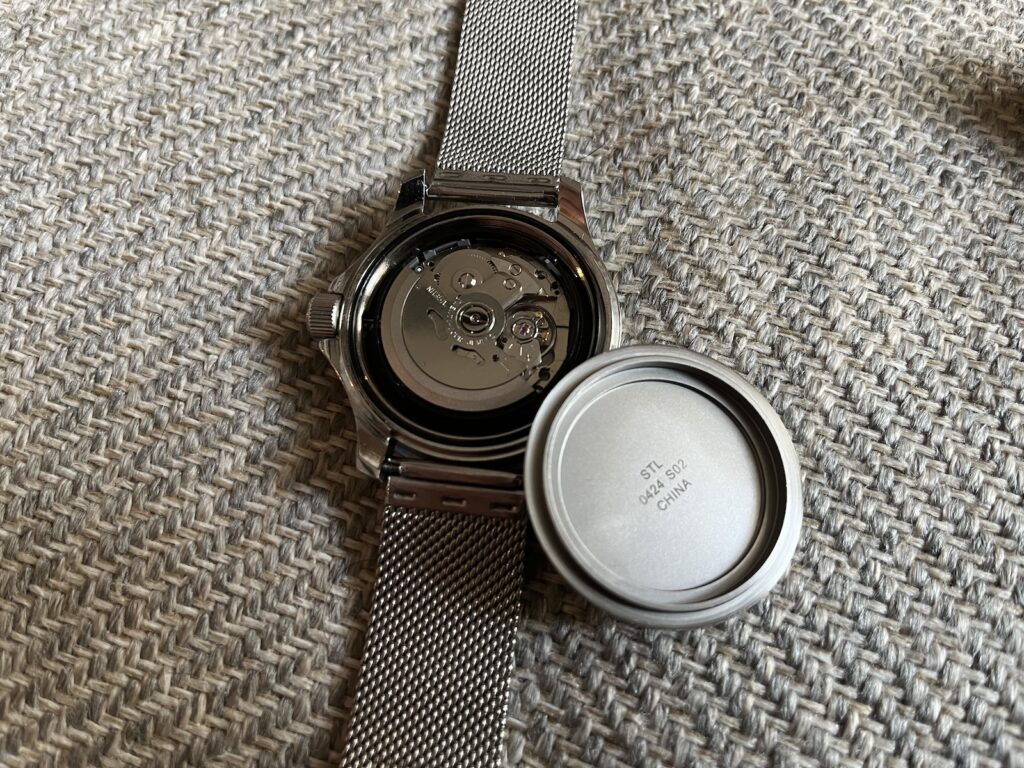
The prevalent, cheap, and reliable NH35 has been increasingly the go-to movement in microbrands and homage brands, with its 41-hour power reserve. The simple three-hand and date movement means you can replace the movement yourself, if so inclined, if and when it craps out. If you’re partial to exhibition case backs, you should know the Henri’s is solid.
Bracelet and Alternatives
The Duxot Henri sports an impressive, albeit uninspired and (in my opinion) outdated 20mm bracelet design that, perhaps unsurprisingly, lacks some of the nicer features of the Omega five-link design it’s mimicking.
Solid links, including the end links, offer confidence, but perhaps some unwanted bulk to the watch, depending on your preferences. Swapping to some aftermarket options made the entire watch feel more well-balanced and reduced some of its weight.
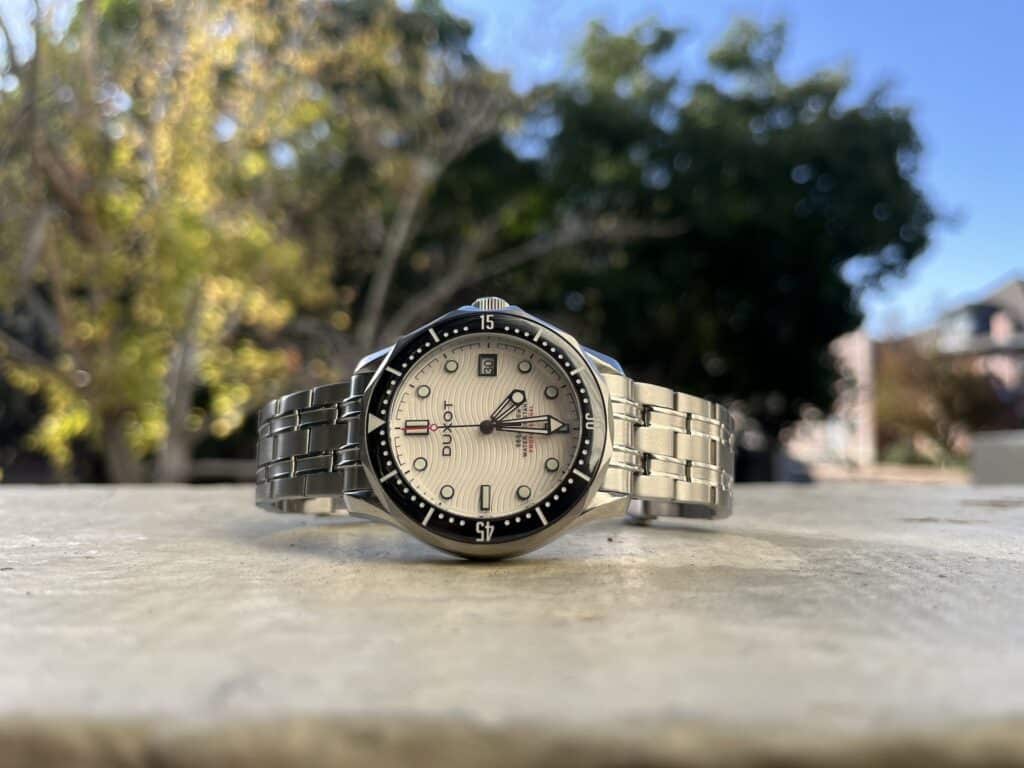
And while the factory bracelet certainly looks nice, I find the design stuck in the 1990s when Pierce Brosnan, in his first film as James Bond, donned the Seamaster Quartz 2541.80.00 in Goldeneye.
Though understandable for a watch of this price, the Duxot lacks independent center links, screw-in pins, and a push-button micro-adjustment clasp—all features you’ll find on the Omega bracelet. The micro-adjustment on the clasp is a standard three-hole arrangement with a spring bar, which can make finding the right size a bit of a pain if your wrist swells and shrinks under different temperatures.
That being said, the watch design lends itself to several straps and bracelets that look great and can transform the look of the watch and the settings in which it might feel appropriate.
As I mentioned earlier in this review, the distance between the spring bar holes and the case body leaves little room for some thicker straps. Even my thinner NATOs had a hard time squeezing in, but at the same time, some thicker two-piece leather straps fit in with ease.
The watch looked quite handsome on a StrapsCo black leather strap with a white contrast stitch and a brown suede vintage-style strap. On NATOs, it was hit-or-miss as far as aesthetics. I was surprised at how much I disliked it on a black CNS NATO with white and red stripes down the center and similarly surprised at how much I liked it on an olive green CNS strap.
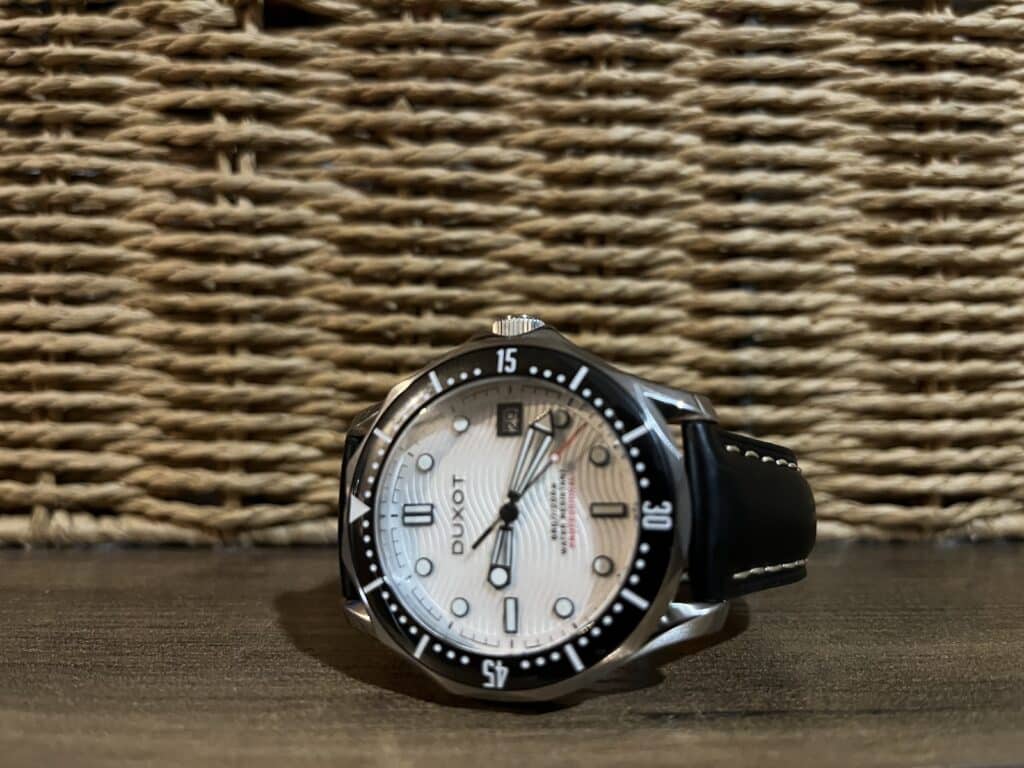
So far, I’ve really been enjoying it on a steel mesh Milanese bracelet, which is similar to what Omega offers. But the look that really drew me to watch in the first place was the white dial on the black Omega rubber strap. Trying on the Seamaster with that strap just looked and felt right, so I’m on the hunt for a similar strap at the moment.
Also on the list for a comfortable and attractive strap for this watch, especially in the fall time, is a braided Perlon strap from Crown and Buckle.
Duxot offers the watch in eight colors—red, dark blue, black, gray, white, light blue, green, and brown—so the strap combinations are nearly endless if you enjoy swapping them as much as I do.
Final Thoughts and Alternatives
Duxot’s Henri is so far scratching an itch I felt when I first tried on the Seamaster that inspired it. For longer-term relief, I’ll eventually need the Omega, but the Duxot, at about 2.5% of the price, at least offers temporary relief and I enjoy wearing it and looking at it.
The overall build quality is on par with the Addiesdives I’ve seen and handled, and appears to be of similar quality to other popular modern Chinese-made watches. While I can’t be certain that’s where the parts other than the movement are made or assembled, the inside of the caseback reads “China” and it did ship from Hong Kong.
I will say that the customer service and shipping time were impressive for a company I hadn’t heard of before a few months ago. The first watch was lost by FedEx and Duxot responded quickly and handled the issue effectively and sent a replacement one, apparently rush shipping it, as the second one arrived in about half the time of the original one.
Despite the visual similarities, don’t expect Omega-quality craftsmanship and avoid paying MSRP. I’d even caution against spending the $400-and-change price it’s often sold for—$149 feels like a good price. I can even see myself spending the $200-and-change Long Island Watch was getting for them when they ran a sale. Keep an eye on both of those websites for markdowns, as they appear to happen often enough.
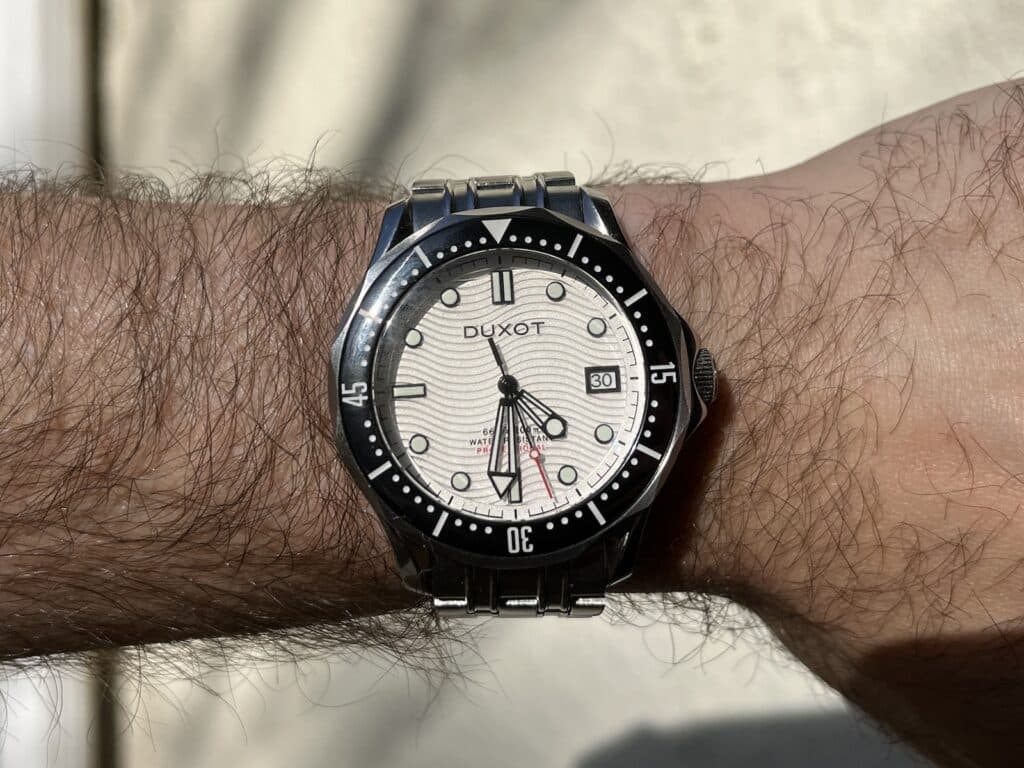
When Omega first debuted the white dial Seamaster, I remember being drawn to it pretty quickly. Before discovering the Duxot, I sought other dive watches with white dials and black bezels and found a ton of great options in various price ranges if that’s what you’re seeking.
Among those include the About Vintage 1956 at $275. The bezel is technically navy blue, but it’s dark enough to where the contrast is still prominent and the dial has a unique textured wave pattern. The Baltic Aquascaphe in classic white at $643 offers a nice step up and can be purchased with an oyster-style or beads of rice bracelet for an additional charge. Then there’s the Vostok Amphibian 200409 which can be found between around $140 and $275, depending on where you shop.
For those who want to stretch their budget a bit more but aren’t quite in the range of Omega, some of the nicer white dial dive watches I’ve found include the Christopher Ward C60 Trident Pro 300, Doxa SUB 200, and Yema Superman 500, all of which hover around $1,000.
If you like the wave pattern but aren’t married to the idea of a white dial, you’re also in luck, as it’s become an increasingly popular aesthetic choice for dials. Among some popular and reliable options are the Christopher Ward C60 #tide (which appears to have been a limited edition offering), Islander Sands Point at $395, Mido Ocean Star 200C at $1,200, Phoibos Wave Master (which TBWS reviewed) for $299 or $399 for the GMT variants, Seiko SRPE39 “Save the Ocean” at $625 (which we also reviewed), Squale 1521 in blue and pink at $1,290 and $1,450, respectively (these also appear to be limited edition models, but can be found online), and the Vostok 130 series, which can be had for around $120.
If, however, you’re seeking something visually close to the Omega Seamaster 300m for the best value, the Duxot Henri might be what you’re looking for. I’d recommend it to anyone looking for a versatile, luxury-style dive watch but with some reservations regarding its overall quality.

The son and grandson of watchmakers, Austen became interested in watches in high school, while working part-time at his father and grandfather’s shop in South Florida. After college and over a decade working in journalism, he developed a passion for watches, growing his collection from a G-Shock and a Seiko SKX173 to over a dozen watches. A sucker for simple and classic designs, dive watches, or the occasional unique dial, his collection is modest and budget-minded, save an Omega “Pre-Bond” Seamaster 200m his father gifted him. When he’s not working as a full-time journalist or playing drums in his band, he’s cuddling with his cat Sox or hiking the mountains of Colorado where he lives with his fiancé.
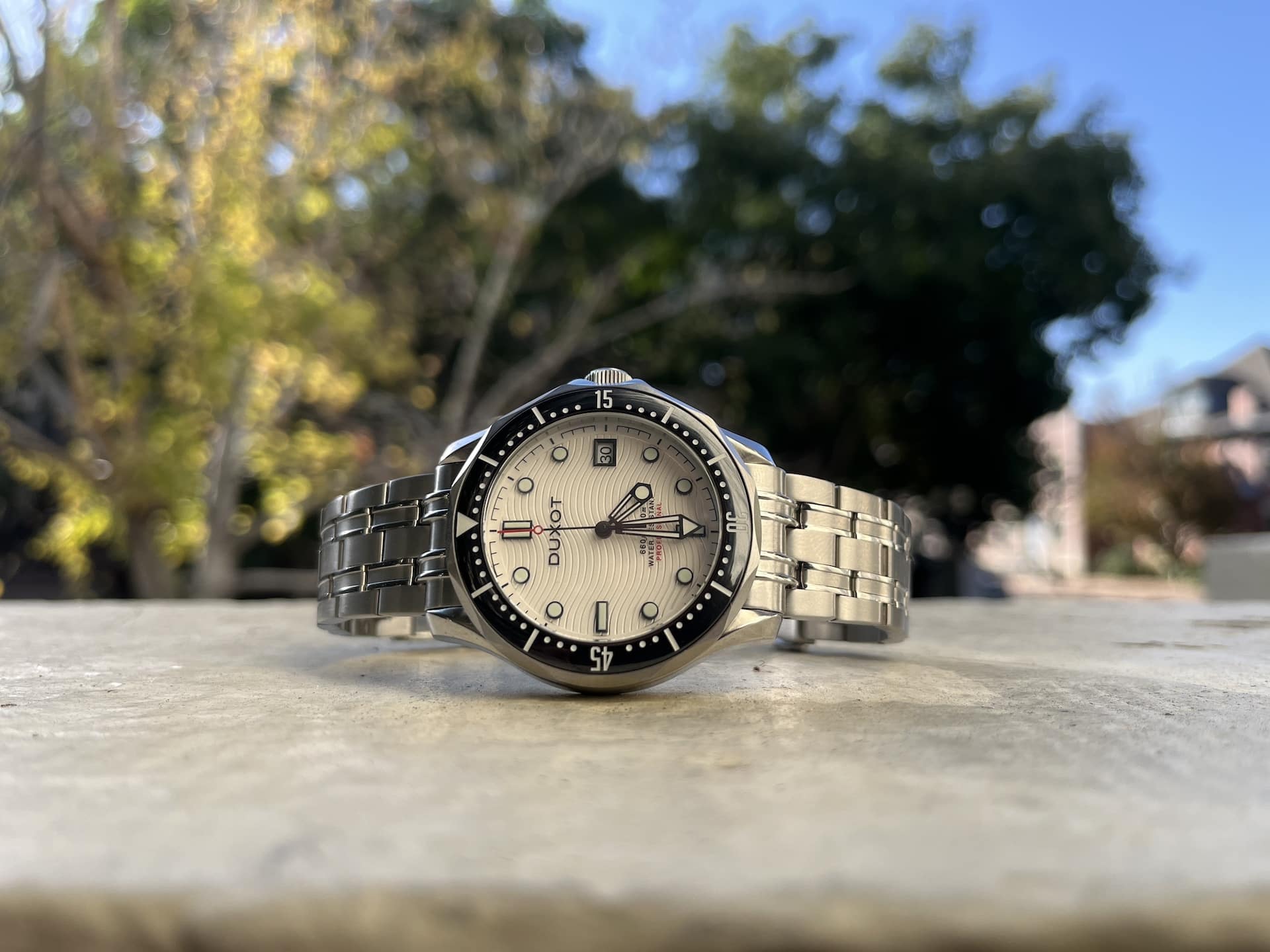
I found this article almost immediately after purchasing this model for $149 US directly from Duxot. I initially saw this on Marc’s LIW, but he didn’t have the colorway I wanted, ice blue. It showed out of stock and $470, just like you mentioned in the article.
A quick search found the model on Duxot’s website. Plus, I got free shipping, which is not something Alaskans universally enjoy. Win-win.
As a budget collector, this is perfect. I get the look of the Seamaster for a price that I can comfortably afford. And I get to try a brand I don’t have a watch from, one element of my mindset in my collecting journey.
I own the Duxot Henri Diver in Ice Blue and man it keeps amazing time. Idk if I just got lucky or perhaps Duxot regulates the watches before shipping. Either way it’s a great watch that is inexpensive. BTW shipping was lightning fast! I ordered it on 1-18 & was wearing it on 1-22.